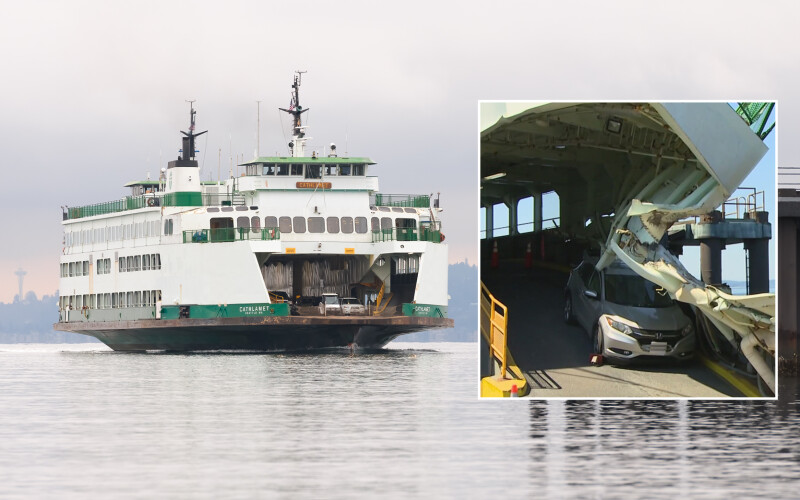Since 2014, the National Transportation Safety Board’s Office of Marine Safety has published the Safer Seas Digest, an annual report examining actions that jeopardize the safety of vessels, personnel, and the environment. The most recent edition, released in June 2024, examines 31 investigations completed by the NTSB in 2023. The report analyzes the causes of these accidents and offers lessons that can be learned from each incident.
FATIGUE RISK
Fatigue is a recurring theme in accident investigations and is cited in several of the 2023 incidents. One of those involved the Cathlamet, a Washington state passenger and car ferry that struck a terminal dolphin at Seattle’s Fauntleroy Ferry Terminal in July 2022.
The ferry’s captain was at the Cathlamet’s wheel as it approached the terminal and its dolphin, which the 328'x78'8" vessel then hit, without speed reduction or course correction. After the allision, the master had to be prompted three times to avoid running aground. There were no rudder commands for 28 seconds before the allision. The incident resulted in one minor injury and $10.3 million in damages.
Fatigue was the obvious issue, NTSB investigators found. The ferry’s master was getting five to six hours of sleep before arriving at the ferry between 0330 and 0345 each morning and would not sleep before assuming command at 0720. Sleep debt builds up over several days for those getting less than eight hours of sleep, which the board said explains why the ferry master did not reduce speed and properly line up the Cathlamet as it approached the dock. The board said the master’s incapacitation was “likely due to a microsleep” — uncontrolled sleep episodes lasting a few seconds. The master said he did not recall what happened.
The repetitive nature of ferry operation can contribute to the microsleep threat. In the Cathlamet report, the board said “Mariners should understand the… dangers of fatigue, such as microsleeps. In addition, repetitive operations such as ferry transits — back and forth on the same route — require operators to sustain a high level of vigilance to prevent complacency.
“Complacency occurs when operators repeatedly complete a task without consequence, desensitizing them to its inherent risk.”
ONBOARD DISTRACTIONS
Cellphone misuse is another common cause of accidents, and it is cited by the NTSB in its report on a July 2022 collision involving two vessels vastly different in size 66 miles south of Port Fourchon, La. The 590'x104' bulk carrier Bunun Queen, traveling 14.4 knots, struck the port side of the 96'x 34' offshore supply vessel (OSV) Thunder, which was traveling at 9 knots.
The board’s accident report notes that “The Convention on the International Regulations for Preventing Collisions at Sea requires that every vessel shall at all times maintain a proper lookout by sight and hearing as well as by all available means appropriate.” Yet, in the period leading up to the collision, the NTSB found that “neither vessel’s officer on watch maintained a lookout—either by visual scanning or by using available electronic means.”
The watch officers on both vessels were involved with non-navigational tasks. The Thunder’s master was using a cellphone, and aboard the Bunun Queen, the second officer was doing other duties while the able-bodied seaman assigned to lookout was resting in his cabin. Each vessel appeared as a radar and AIS target on board the other vessel, but neither vessel was being tracked.
The Bunun Queen’s bow struck the Thunder’s port side, flooding the OSV’s propulsion room and three other spaces. Eleven of the 18 crew were evacuated. The other seven remained aboard to control flooding while the vessel was towed to port. Damage to both vessels totaled $12.3 million.
FIRE DETECTION
Of the 31 accidents analyzed, several resulted in the NTSB recommending new safety regulations to the Coast Guard. One recommendation stemmed from a June 2022, engine-room fire on the 169' passenger vessel Spirit of Norfolk while it was on a sightseeing cruise on the Elizabeth River, near Norfolk, Va. Aboard were 108 people, including 91 passengers (36 of whom were children), seven crew, and 10 hospitality staff.
Firefighters could not gain access to the engine room, which was consumed by thick black smoke and flames. Passengers and crew were transferred to a Good Samaritan vessel. The Spirit of Norfolk was towed to a pier at Navy Station Norfolk, but only after four days was the fire extinguished. The vessel, valued at $5 million, was a total loss.
The NTSB determined that the fire started in the engine room and was likely sparked by combustible materials stored near the port generator exhaust piping. Due to regulatory exemptions, no engine room fire detection system was required. This delayed discovery of the fire and allowed it to grow. In addition, there were no requirements for a fixed gas fire-extinguishing system, and thus, no safe methods for fighting the fire.
The NTSB recommended that the Coast Guard require “existing exempted Subchapter K small passenger vessels that were in operation as of March 10, 1995, be fitted with a fire-detection system and a fixed gas fire-extinguishing system in their engine rooms.” The board also proposed improved contingency planning for marine firefighting.
MAINTENANCE SHORTFALLS
Neglected vessel maintenance is often the cause of disaster, as was seen in a June 2022 Gulf of Mexico capsizing. The 195'x70' crane barge Ambition — made up of two barges, one 27 years old and the other 24 years old, that were welded together in 2020 to create a deck barge — was being towed toward the Mississippi River by the 94'x29' Karen Koby. The Ambition suffered from a lack of watertight integrity, with at least six hatch covers either missing or not secured. Nearly five hours into the trip, the Karen Koby’s speed dropped, and about 30 minutes later, the Ambition capsized and partially sank in about 54' of water. No one was injured, and damage was estimated to be $6.3 million.
The “barge owner’s lack of hull inspection and maintenance and not conducting permanent repairs” was cited as the probable cause. Corrosive deterioration of bottom and bilge knuckle plating and their subsequent separation allowed for progressive flooding that caused Ambition to heel to port, exposing an open hatch to seas reaching the main deck.
The barge’s owner did not have an inspection or maintenance plan for Ambition’s hull, and thus permanent repairs were not made in critical areas.




